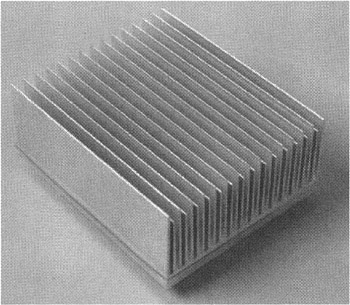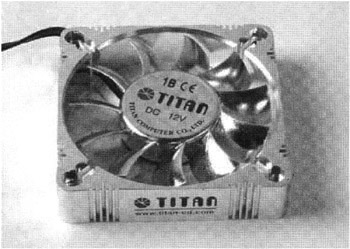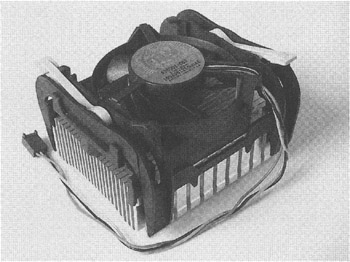Heatsinks and Fans
|
| < Day Day Up > |
|
Heatsinks allow you to guarantee the best temperature conditions for electronic components. Heatsinks intensify the heat exchange between cooled elements, such as the CPU or video chipset, and their environment. This occurs because the heatsink area is significantly larger than the area of the cooled element. The greater the heatsink surface area, the more intense the heat dissipation from the cooled element. Numerous technologies are used for heatsink manufacturing, and these affect the quality. Note that most high-quality heatsinks are not only effective, but expensive as well. Usually, these high-priced heatsinks are the best choices for a cooling system.
A heatsink must have good thermal conductance and thermal resistance. Thermal conductance determines the speed of heat propagation. For a heatsink, thermal conductance must be as high as possible, because the area of the cooled object is often several times smaller than the area of the heatsink base. If thermal conductance is low, the heat from the cooled object won't be distributed evenly over the volume of the heatsink, including all its fins. On the other hand, if the heatsink is manufactured from a material with high thermal conductance, the temperature will be the same throughout it. As a result, the heat will be dispersed with equal efficiency from the entire heatsink area. This means one part of the heatsink will never be very hot while another part remains cold (and, consequently, doesn't radiate heat into the ambient air).
As illustrated in Table 10.1, two materials are the most suitable for heatsink manufacturing: aluminum and copper. Aluminum is a good choice because of its low cost and high thermal conductance; copper also has high thermal conductance. Silver is too expensive to be used for heatsink manufacturing. Disregarding its relatively high price, this metal is best for manufacturing only heatsink bases because of its high thermal conductance.
| Material | Thermal conductance (W/m × K) | Specific heat (J/kg × K) | Density (g/cm3) |
|---|---|---|---|
| Aluminum | 238.0 | 880 | 2.7 |
| Copper | 398.0 | 385 | 8.9 |
| Gold | 322.0 | 130 | 19.3 |
| Lead | 35.1 | 130 | 11.3 |
| Nickel | 90.1 | 460 | 8.9 |
| Silver | 418.7 | 235 | 10.5 |
Heatsinks are usually made from aluminum — an inexpensive material with high thermal conductance (Fig. 10.1). Copper is better, but much more expensive. Copper also weighs much more, which would increase the weight of the heatsink and complicate mounting.

Figure 10.1: Heatsink for a processor
Dark objects radiate heat better than light ones. This is why the preferred heatsink color is black. Note that the black color is achieved through special technology, such as chemical treatment or applying special coating by means of sputtering. You couldn't just paint the heatsink black; paint is a heat insulator, rather than a conductor.
The most important characteristics of a heatsink are its thermal conductance factor and thermal resistance factor. Thermal resistance is a variable — the opposite of thermal conductance — that largely depends on the material from which the heatsink is made. Thermal resistance is measured in °C/W. Keep in mind that the value of this parameter is affected not only by the material of the heatsink, but also by its size, its form, the technology used, the quality of manufacturing, etc. Thermal resistance is the increase in the heatsink temperature relative to the temperature of its immediate surroundings when a cooled element, such as a processor, with a 1 W power capacity is dissipating heat. For example, with a thermal resistance of 2°C/W and dissipation from a processor that uses 15 W, the temperature will increase 30°C. The value of this parameter is usually between 0.5°C/W and 2°C/W. The design of the heatsink plays a key role, one more important than even its size. This is why bigger is not necessarily better.
The best cooling devices have a construction that consists of a heatsink and a fan. The fan is usually set over the heatsink, which is attached to the object to be cooled. The fan moves hot air from the heatsink while supplying it with cool air. (Fig. 10.2).

Figure 10.2: Fan for a CPU cooler
There are several types of fans; the most common ones on CPU heatsinks are sleeve-bearing fans and ball-bearing fans. Fans with ball bearings are preferable, because sleeve bearings (also known as slide or plain bearings) generally are less reliable and make more noise. On average, fans that use ball bearings work twice as long as the ones that use sleeve bearings. Note that most popular fans labeled "ball bearing" actually have one ball bearing and one sleeve bearing. Most overclockers highly recommend buying purely ball-bearing fans, also known as double ball-bearing coolers. By using a double ball-bearing cooler, the service life of the fan is at least 1.5 times longer than the life estimated for a cooler that uses both types of bearings.
The life of a fan is usually two to three years. At least once a year, you should clean the dust that collects on the fan. The dust accumulates with time and may degrade the parameters of the cooling equipment significantly or even stop the fan completely. If the cooler fails, the cooled component (processor, video chip, etc.) also will fail soon because of overheating. To avoid processor overheating caused by a fan failure, modern hardware and software components including the processor, motherboard, BIOS, and system software provide a system of preventive defense against overheating. Such a system includes sensors that control both the temperature and the voltage. When buying hardware components, make sure that this function is present.
There are three basic performance parameters of the fan: cubic feet per minute, linear feet per minute, and revolutions per minute.
-
The volumetric flow rate is measured in cubic feet per minute (cfm). It shows how many cubic feet of air the fan blows per minute. For most modern CPU fans, this parameter is between 10 cfm and 12 cfm.
-
The linear flow rate of the air is measured in linear feet per minute (lfpm). Typical values are between 500 lfpm and 600 lfpm. Multiplying the lfpm value by the cross-section area of the airflow from the fan returns the cfm value.
-
The fan speed is measured in revolutions per minute (rpm). Typical values for this parameter are between 4,000 rpm and 6,000 rpm.
The larger the value of each parameter, the higher the performance of the fan, and the better its performance as a cooling system element.
The dimensions of fans for modern processors are usually 50 × 50 × 10 mm.
The noise level, measured in decibels (dB), also characterizes the quality of the fan. A high noise level may irritate and annoy you. High-quality fans have a noise level of between 20 dB and 25 dB. (The lower the noise level, the better.) Sometimes, a high noise level is caused by the construction of the fan. Therefore, another sign of a high-quality fan is the absence of strong vibrations. If you feel the fan vibrating while you hold it in your hand, then the fan is not of a high quality, and you should look for a better one.
Usually, a cooling device consists of two parts: a heatsink and a fan, which work together as an efficient high-performance cooler. When selecting the best cooler, pay attention to the brand-name products of well-known manufacturers. In general, these products are highly reliable and have stable parameters. Examples of such coolers include the products from companies such as Intel, Titan, Thermal-take, Iwill, Asus, Sanyo, and AVC.
The Intel cooler shown in Fig. 10.3 is supplied with Intel Celeron 2 GHz processors in the box version. This cooler is optimal for these processors and can be used with them in both nominal and moderate overclocked modes (10%–20%). However, if you are using extreme overclocked modes, characterized by high frequencies and voltage levels, you should use either Intel coolers supplied with more powerful models or implement more intense cooling. Such cooler models include TTC-D2T, TTC-D3T, and TTC-D3TB from Titan, and Chrome Orb and Super Orb from Thermaltake.

Figure 10.3: Intel cooler recommended for Celeron 2 GHz
Without covering the constructive details of popular coolers, we should point out that their parameters are similar. This is especially true for the products from Titan and Thermaltake. Tests have shown that the temperature modes of the processors supported by coolers from these vendors differ within a range of 3–5 degrees Celsius. Within between 50°C (122°F) and 60°C (140°F), this difference is insignificant. Other factors, such as cable layout (which influences air circulation within the system unit) and supplementary fan positions, frequently have a greater effect on the temperature modes of the processor.
Keep in mind that the processor is not the only component that requires intensive cooling. Intensive cooling often is required by the integrated circuits that form chipsets, by video adapters, and by certain types of memory chips. It is also strongly recommended that you cool high-performance, large-capacity hard drives; their operation is accompanied by considerable heat release, especially in overclocked modes.
|
| < Day Day Up > |
|
EAN: 2147483647
Pages: 111